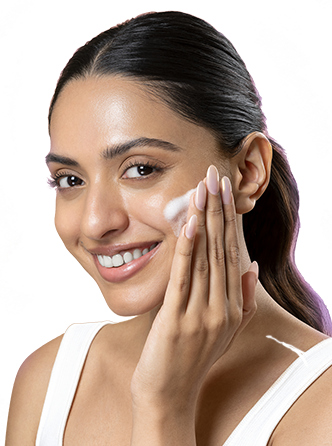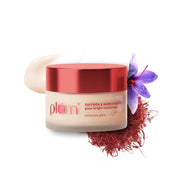
IN THIS ARTICLE
My skin is normal, but nowadays it feels sticky, and at times it's very dry….
My skin feels dry after I wash my face, but after I apply sunscreen it becomes oily…
My skin just does not feel fresh in summers. Its either dehydrated or oily or at times both
My cheeks are dry, but my forehead shines like anything…
Sounds familiar? That's combination skin for you! And did you know that the weather (e.g. an intense summer) can leave your skin with alternating moments of oily, dehydrated, itchy sensations – making it a combination skin type? There could also be other reasons as well as to why your face skin would reveal a combination of skin types – these range from hormonal imbalances to pollution in the air to plain stress or even passive smoking.
If you're wondering what is combination skin, it typically means having oily areas (especially in the T-zone) and dry or normal areas elsewhere. This combination skin type can feel confusing, but with the right care, it's completely manageable.
Combination skin care steps
As complicated as it may sound, it's not that hard to take care of combination skin. Remember these 4 basics of a good combination skin care routine:
-
Always cleanse mildly without over-stripping your skin of its essentials
-
Always be measured in your moisturising, apply only just what is required
-
Never step out into the sun without protection.
-
Stay away from irritants, strong fragrances and harmful ingredients such as SLS, parabens and phthalates (more on this later)
To make things easier, let’s break it down to a simple daily combination skin care routine you can follow.
Cleansing – The first step to treat combination skin
Always start your skin care routine for combination skin with mild but effective cleansing. Daily cleansing is essential, especially in polluted or humid climates. A gentle cleanser with vitamins and antioxidants is ideal for a combination skin type.
And remember, your daily mild cleanser should always avoid harmful ingredients such as
-
SLS (Sodium Lauryl Sulphate)- a commonly used surfactant that creates lather in shampoos, toothpastes etc. but irritates the skin - read about SLS here
-
Parabens –widely used preservatives in personal care products but in the grey zone of safety. Read about parabens here.
-
Phthalates-widely used plasticizer in products such as nail polish, aftershave lotions, soaps, shampoos, perfumes etc. with somewhat scary side effects. Catch the dope on phthalates here.
The right way to cleanse combination skin
1. Wet your face with water.
2. Squeeze out a coin-sized amount of face wash on your palm.
3. Gently rub on your face, for a few seconds. If the face wash has scrub particles, apply light pressure while using it.
4. Gently rinse away with water and pat dry with soft towel (don't scrub your face with the towel!)
Usage timing and frequency:
Cleanse twice a day – morning and before bed – to maintain a healthy combination skin care routine.
Toning – balancing your combination skin
Some think toner is only for oily or acne-prone skin, but it’s quite beneficial for combination skin type care as well.
A good toner helps:
- Shrink pores
- Hydrate your face
- Control oil in the T-zone
- Maintain balance in dry areas
Choose a toner with natural astringents like green tea or witch hazel. Avoid alcohol-based formulas as they dry out skin.
How to Use Toner for Combination Skin
- Splash directly or apply with a cotton ball.
- Focus on the T-zone, nose, forehead, and chin.
- Let it air dry.
Use it twice daily post-cleansing.
Moisturising and sun protection for combination skin
Moisturising is essential, even for combination skin. Many ask, is hyaluronic acid good for combination skin? — yes, it’s excellent! It hydrates dry areas without making oily zones greasy.
A moisturiser with SPF protects from UVB rays. Dermatologists in India recommend SPF 15–30 for daily use.
How to Moisturise Correctly
-
Dot your face (forehead, cheeks, nose, chin)
-
Massage gently with upward motions
-
Include neck and arms
-
Reapply every 3–4 hours if out in the sun
-
Use a night cream if you're 30+ for better hydration
This is an important part of your combination skin routine to keep your complexion healthy and protected.
Weekly combination skin care routine and home remedies
Your daily routine is essential, but once a week, treat your skin with home remedies for combination skin that include:
-
Deep cleansing
-
Exfoliating
-
Face masks for hydration and balance
How to use a face mask for combination skin
-
Cleanse thoroughly, focusing on the forehead and chin.
-
Apply a thin, even layer – avoid eyes and lips.
-
Leave for 15 mins or until fully dry.
-
Rinse with water and pat dry.
-
Apply moisturiser to seal in hydration.
Frequency: Use once a week for visible results.
This might seem like a lot, but your combination skin care routine can become second nature just like brushing your teeth!
Your combination skin needs regular care to stay radiant. From knowing how to treat combination skin to building the right steps into your daily regimen, it all adds up to long-term skin health. Now that you understand the combination skin type meaning, you’re ready to give it the attention it deserves.
FAQs
1. What is the best skincare routine for combination skin?
The best skincare routine for combination skin is made up of products that address both the oily T-zone and dry areas effectively.
It should include a gentle cleanser, targeted serum, alcohol free toner, and a broad-spectrum sunscreen. In the nighttime routine, ensure to do a double cleanse to remove all dirt and gunk.
2. How do I balance oily and dry areas on combination skin?
Following are some tips to balance your combination skin:
-
Use a mild cleanser for the whole face.
-
Apply oil-free products on the T-zone and hydrating creams on dry areas.
-
Avoid overwashing or heavy products that can exacerbate oiliness or dryness.
3. What ingredients should I look for in products for combination skin?
Ensure your skincare products have the following ingredients for best care:
-
For Hydration: Hyaluronic acid, glycerin.
-
For Oil-controlling: Niacinamide, salicylic acid.
-
For Soothing: Aloe vera, green tea extract.
4. Are there specific moisturizers that work well for combination skin?
-
Use lightweight, gel-based moisturizers that hydrate without clogging pores.
-
Avoid heavy creams; opt for oil-free, non-comedogenic formulas.
5. What should combination skin avoid?
If you have combination skin, you must avoid the following:-
-
Harsh cleansers and alcohol-based toners that strip moisture.
-
Heavy, occlusive products that clog pores.
-
Overwashing, as it can make dry areas drier and oily areas oilier.
Related posts
A step-by-step guide to care for oily skin
5 at-home skin care tricks for the weekend
Which is the right toner for you?



















